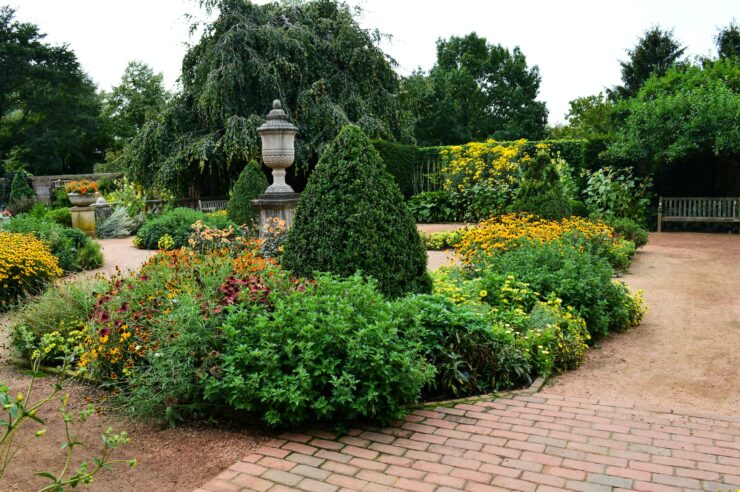Revamping your garden is a transformative endeavor, infusing vitality into your outdoor haven, rendering it both aesthetically pleasing and purposeful. Regardless of whether you’re commencing from square one or refurbishing an established garden, a meticulously crafted renovation blueprint is paramount for attaining your envisioned outcome. This piece will delve into five pivotal tips to renovating your garden, enabling you to craft an awe-inspiring outdoor sanctuary that exudes beauty and tranquility, ultimately elevating your overall living experience.
Define Your Garden’s Purpose And Style
Before you dive into any renovation project, it’s crucial to have a clear vision of what you want your garden to be. Pose inquiries such as: What is the main objective of the garden? Is it a serene retreat for relaxation, a lively space for entertaining, a practical vegetable garden, or a combination of these elements? Additionally, consider the garden’s style. Are you drawn to a formal, structured design, or do you prefer a more natural, cottage garden look? Defining the purpose and style will serve as your foundation for the entire renovation process. It will help you make informed decisions about layout, plant selection, and the overall aesthetic of your garden.
Tip: Regardless of how you intend to define your garden, a cost-effective tip for cultivating it is to seed or turf the garden independently, absent a contracting service. Moreover, the labor you invest in preparing your garden will provide you an additional amount of ownership in ensuring it’s ultimate outcome.
Assess Your Garden’s Condition – Renovating Your Garden
Before you start tearing out plants or adding new features, take the time to assess the current condition of your garden. Walk through the space and make note of any existing plants, structures, or elements you want to keep. Identify any issues such as drainage problems, soil quality, or pest infestations that may need attention. Conducting a soil test yields essential data on your soil’s pH and nutrient content, aiding in the selection of suitable plants and necessary amendments. This assessment phase will also help you determine whether any trees or shrubs require pruning or removal to improve the garden’s overall health and aesthetics.
Tip: Upon assessing your garden assiduously, you’ll gather a proper inventory of the materials you possess, and do no possess, to manifest your intended conception of the garden’s layout. Don’t hesitated to use old materials to reinvent your garden. Though they may be weathered, that doesn’t necessarily mean that they are not useful.
Plan Your Layout And Hardscape Features
The layout and hardscape features of your garden form its structural framework. Start by sketching out a rough plan of where you envision various elements, such as pathways, patios, seating areas, and focal points like fountains or sculptures. Consider factors like sunlight exposure and privacy when deciding on placement. Hardscape materials play a significant role in garden renovation. Options like stone, wood, gravel, or concrete can be used to create paths, borders, and seating areas. Choose materials that align with your garden’s style and ensure they are durable and weather-resistant. Remember to plan for accessibility, allowing for smooth navigation through the garden. Well-designed pathways not only enhance the garden’s functionality but also contribute to its visual appeal.
Tip: One way to enhance accessibility, or walkability, in your garden is to install gravel paths. It’s aesthetically pleasing and can confer a sense of direction to guests and you alike.
Select The Right Plants – Renovating Your Garden
Choosing the right plants is a pivotal aspect of garden renovation, as it significantly contributes to the garden’s overall aesthetics and functionality. Begin by considering the purpose of your garden: Is it meant to be a vibrant floral paradise, a tranquil green sanctuary, or a combination of both? Once you’ve defined the garden’s purpose, delve into the exciting world of plant selection. Engaging in research about native plants is a wise strategy, as they are inherently suited to the local climate and soil conditions. This often results in lower water requirements and maintenance needs. Beyond this, consider the aesthetics: think about the color palette you envision, the seasons you’d like your garden to come alive in, and the level of maintenance you are willing to commit to. Seasonal interest is key – select a variety of plants that bloom and flourish at different times of the year to ensure your garden remains captivating throughout the seasons. Additionally, factor in wildlife attraction by incorporating plants that draw in birds, butterflies, and pollinators, enhancing both your garden’s biodiversity and your viewing pleasure. Ultimately, making informed choices about plant selection will not only result in a visually pleasing garden but also ensure that the plants thrive in their new environment, contributing to the long-term success of your garden renovation project.
Tip: In order to ensure the flourishing of the plants you seed, invest in weeding equipment. There is nothing more obstinate and irritating than weeds unwontedly grasping for air in the crevices of your crops or flowers. For more information on how to properly prune your garden, visit this site.
Implement Sustainable Practices
Incorporating sustainable practices into your garden renovation is a holistic approach that not only benefits your immediate outdoor environment but also contributes to a healthier planet. By embracing eco-conscious methods, you can create a garden that thrives while reducing its ecological footprint. Start by prioritizing water efficiency. Install a drip irrigation system or rain barrel to conserve water, making sure to group plants with similar water needs together. This not only saves resources but also lowers your water bills. Mulching is another sustainable practice that should not be overlooked. Applying organic mulch not only conserves moisture but also suppresses weeds and improves soil quality. Additionally, it provides an appealing final touch to your garden beds. Composting is a valuable step in your sustainability journey. Starting a compost bin allows you to recycle kitchen and garden waste into nutrient-rich compost, reducing the need for chemical fertilizers and enriching your soil naturally. The use of native plants is a cornerstone of sustainable gardening. Native species are adapted to local conditions, reducing the need for excessive water, fertilizers, and pesticides. They also provide habitat and food for local wildlife. Lastly, embrace chemical-free gardening. By integrating these sustainable practices into your garden renovation, you create an environment that not only flourishes but also stands as a testament to your commitment to a greener, more eco-friendly world.
Tip: If you’re an aspiring horticulturalist, click here for some beginner tips on the rudiments of gardening.
Conclusion – Renovating Your Garden
Undertaking a garden renovation is a gratifying venture that holds the promise of transforming your outdoor space into a sanctuary of unparalleled beauty and tranquility. It begins with a clear definition of your garden’s intended purpose and chosen style, followed by a thorough assessment of its current state. Thoughtful planning, including layout design and selection of hardscape elements, is crucial. Careful plant selection and incorporation of sustainable practices are also pivotal in ensuring a thriving garden. Remember, a garden renovation is an ongoing, dynamic journey, and with tender care, it will flourish, bestowing joy for years to come.




